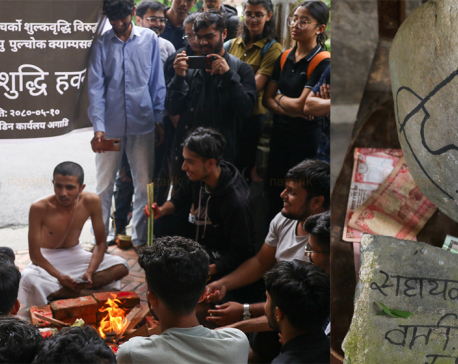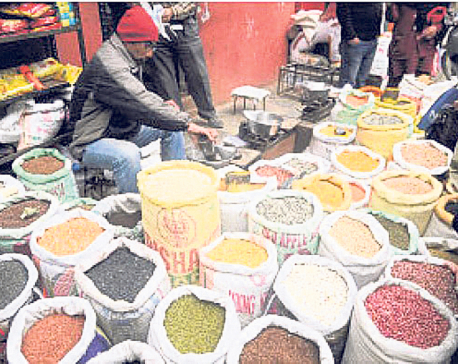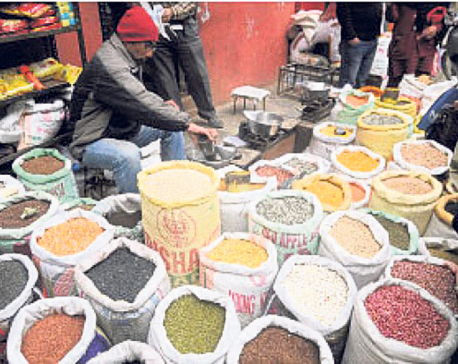
OR
Shoppers hit hard by excessive price rise of most essentials during festival
Published On: October 24, 2022 03:35 PM NPT By: Rajesh Khanal and Sajira Shrestha

KATHMANDU, Oct 24: Shoppers during the festivals this year have a hard time managing expenses due to rampant hikes in market prices.
This year, the prices of almost all goods, which are in high demand during Dashain and Tihar, have escalated by a notable amount, said shopkeepers. According to them, outfits, decorative lights, flower garlands, ghee, wheat flour and a number of dry fruits, among others, have become dearer.
Nani Maiya Pathak, a flower seller in Bhaisepati, Lalitpur, told Republica that the price of garland of marigold has gone up to two-folds this year compared to the prices in Tihar last year. “A garland that used to cost Rs 450 is available now only for Rs 750. Likewise, the garland that cost Rs 800 last year now costs up to Rs 2,000 per unit,” she said.
Nepal Rastra Bank recorded consumer price inflation at 8.64 percent in the first two months of the current fiscal year, which was more than double the figure during the period last year. The average of food and beverage inflation stood at 8.17 percent whereas the prices of transportation escalated by 23.41 percent.
Although price rise has emerged as a consequence of petroleum price hike and disruption in supply chain in the aftermath of the Russia-Ukraine war, China’s unannounced blocking of land trade routes and India banning the export of a number of food items, the prices in local markets have increased in abnormal ways.
A retailer in Baluwatar said the price of wheat flour increased by around 50 percent recently. “Until a month ago, wheat flour cost around Rs 52 per kg, which has now gone up to Rs 75 per kg. Likewise, ghee is expensive by around Rs 50 per kg,” said the retailer, on condition of anonymity.
Electric decorative lights have also been dearer by around 30 percent, which according to the sellers, is due to the traders being unable to import the Tihar items in adequate quantity from China. On the other hand, the prices of dry fruits that are high in demand in Tihar, remain fairly stable.
Bikki Rauniyar, a shopkeeper in Makhan Tole of Kathmandu, said the prices of only a number of dry fruits have surged this time. According to him, they are compelled to sell old products due to the government's restriction on opening letters of credit for importing dry fruits. “The price of pistachio however has increased by Rs 300 per kg while that of walnut has increased by up to Rs 150 per kg.”
Besides these, the apparels have also been expensive this year. Harsha Gupta, a wholesaler of kids wear at Mahabauddha, said there are not many customers compared to previous years due to excessive price rise. According to him, the soaring price of the US dollar and the Chinese government’s restriction on all the exports coming from Khasa and Kerung borders without any prior notice also increased the import cost for traders.
Roshan Sainju, proprietor of Brother’s Fashion, Bhaktapur, said the sale is very down this year. According to him, business volume is half while profits have also dropped heavily this year compared to the previous years. “There is a hike in the prices of almost every product. Comparatively, the price hike is around 20 to 30 percent even in the wholesale market. For instance, the price of a product which was Rs 1500 earlier now is in the range of Rs 1800 to Rs 2000,” Sainju said.
Arina Karki, a customer found shopping in the Bhotahity area, said the price has increased haphazardly. According to her, a shirt that may cost just Rs 1500 is now being sold at Rs 2000. Karki said the policy of Kathmandu Metropolitan City not allowing street vendors to sell their goods on footpaths has also affected the market price this time. “Due to this, there is less competition in the market and shopkeepers have increased the price of their products.” Karki added.
You May Like This

Pulchowk Campus students protest against fee hike by performing Hawan (In Photos)
KATHMANDU, Aug 27: Students of the Pulchowk Engineering Campus have taken a unique approach to protest against engineering fee hike... Read More...

Govt starts selling subsidized essentials from 41 fair price shops across the country
KATHMANDU, Sept 17: The government has started operating nearly three dozen fair price shops in 38 districts from Saturday with the... Read More...

Fair price shops in three dozen places from Sept 28
KATHMANDU, Sept 14: The government has announced plans to open fair price shops on the eve of festive season in various... Read More...






Just In
- Challenges Confronting the New Coalition
- NRB introduces cautiously flexible measures to address ongoing slowdown in various economic sectors
- Forced Covid-19 cremations: is it too late for redemption?
- NRB to provide collateral-free loans to foreign employment seekers
- NEB to publish Grade 12 results next week
- Body handover begins; Relatives remain dissatisfied with insurance, compensation amount
- NC defers its plan to join Koshi govt
- NRB to review microfinance loan interest rate











Leave A Comment